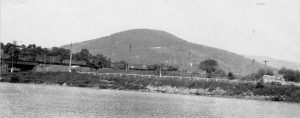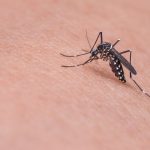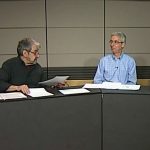
The history of Angelica Creek is wrought with human intervention.
In 1885, the Angelica Water Company erected a dam and interrupted the creek’s flow. Behind the dam, Angelica’s waters settled into a lake which served the surrounding community first as a reservoir and then later as a natural source of ice. Once industrial activities ceased, the City of Reading took ownership of the dam and Angelica Lake became a popular spot for fishing and boating.
Then in 2001, Tropical Storm Allison tore through Berks County, emboldening Angelica Creek to breach the dam and flow forward unabated. The Angelica Dam was never rebuilt. Instead, the City of Reading chose to repair the natural rhythm of the waterway and its surroundings by establishing a 71-acre environmental park along the creek: Angelica Creek Park.
Thus, began a new chapter of human intervention for Angelica Creek, a chapter of restoration penned in partnership with Berks Nature, who is leading on-the-ground management and stewardship of Angelica Creek Park.
Restoration of Angelica Creek Park began in 2006, 5 years after the dam’s breach, and continues today. In 2020 alone, Berks Nature planted over 162 new native trees and shrubs, with the support of the Mid-Atlantic Renewable Energy Association, Penske, and other community volunteers.
With every new habitat restoration project, Berks Nature applies a three-pronged restoration regimen: horticulture considers the cultivation of the new plant community by appropriately timing planting efforts; biology strives to build a new plant community that mirrors the existing environment; and ecology prioritizes the functionality and value of the new community into the future.
While the same principles apply to Angelica Creek, Berks Nature, whose offices are housed at Angelica Creek Park, have taken a more experimental approach to managing the parkland’s new habitats.
“For projects out in the community, at farms and schools and parks, we might come once or twice a year,” explains Sarah Chudnovsky, Berks Nature’s Land Protection Specialist, “Angelica Park is unique because it’s our home as Berks Nature. We can return day after day and season after season to invest in the long-term stewardship and care. If some shrubs don’t make it in a spring planting, it’s easier for us to re-assess and replant in the fall, perhaps in a slightly different spot, or try a different species.”
In this way, Angelica Creek Park is a living laboratory.
In early efforts to establish a diverse wetland community, Berks Nature noticed generalist species capable of thriving under a variety of conditions supplanting specialist species with more specific and therefore sensitive survival requirements; the excessive nutrient loads delivered by urban and surburban stormwater entering Angelica Creek proved too much for specialists but tolerable for generalists.
Over time, Berks Nature also watched upland plant species ceded to a more sodden community of plants as previously dry portions of the drained lakebed grew soggy and saturated.
“Restoration isn’t about returning to any point in time,” Chudnovsky explains, “it’s about changing the conditions.”
Consider this: over one hundred years ago, Angelica Lake froze so deeply that the Reading Cold Storage & Ice Company could harvest and sell great blocks of ice. But during the winter of 2019 into 2020, Berks County was only chilled by a handful of snow falls accumulating just 5 or so inches of snow. Restoration projects like these are not about reliving a past timeline; our ever-changing world has already moved on. Instead, restoration focuses on rebuilding the integrity and functionality of ecosystems today and into the future.
For Pennsylvania, the future is looking warmer and wetter.
Greenhouse gases, like carbon dioxide, are accumulating rapidly in the Earth’s atmosphere, increasing the planet’s temperature and fueling global climate shifts. According to the Pennsylvania Department of Environmental Protection, temperatures in Pennsylvania have already increased by nearly 2° F since the early 20th century and are could increase by an additional 4.9°F by 2050. Annual precipitation in Pennsylvania is also on the rise, increasing by approximately 10% since the early 20th century and continuing to climb by a projected 8-12% by 2050.
What does this mean for you? Hotter summers, wetter storms, and more extreme flooding. Fortunately, the City of Reading has created a Climate Action Plan to strengthen the city’s climate resiliency and organizations like Berks Nature are stewardingnew environmental restoration projects, like the Angelica Creek Park restoration, which mitigate climate change by improving ecosystem functionality.
Angelica Creek now flows through its former lakebed, weaving between two wetlands. Cattails and other wet-loving plants flourish in the soggy soils while native trees and woody shrubs – sycamore, swamp white oak, and osier dogwood – have taken root along Angelica’s banks. This varied assemblage of native wetland and riparian plants provides rich wildlife habitat for birds, like the red-winged blackbird boldy belting its conk-la-ree melody, and mammals, like the red fox furtively tiptoeing through stands of tall, reedy grass.
This wetland nexus is also designed to collect and filter stormwater, an emerging challenge for Berks County’s streams as extreme weather events increase in frequency and the prevalence of paved surfaces across the watershed increases flooding volumes. Angelica Creek’s wetland complex includes a retention pond, upon which a Biohaven wetland island floats. Lush with native plants, the floating wetland recycles excess nutrients carried by stormwater that could otherwise sicken the stream.
The once barren lakebed now burgeons with a vibrant community of wetland and riparian plants. This verdant community sequesters carbon and acts as a natural filter for rain and stormwater, allowing water to soak into the soil, increasing groundwater recharge, and reducing the risk of flooding.
Before the Angelica Dam breached, the lake and its surrounding area met a singular purpose: recreation. Today, the restored wetland ecosystem of Angelica Creek Park is a living, evolving model of resiliency, reclamation, and transformation serving human and non-human communities alike.





